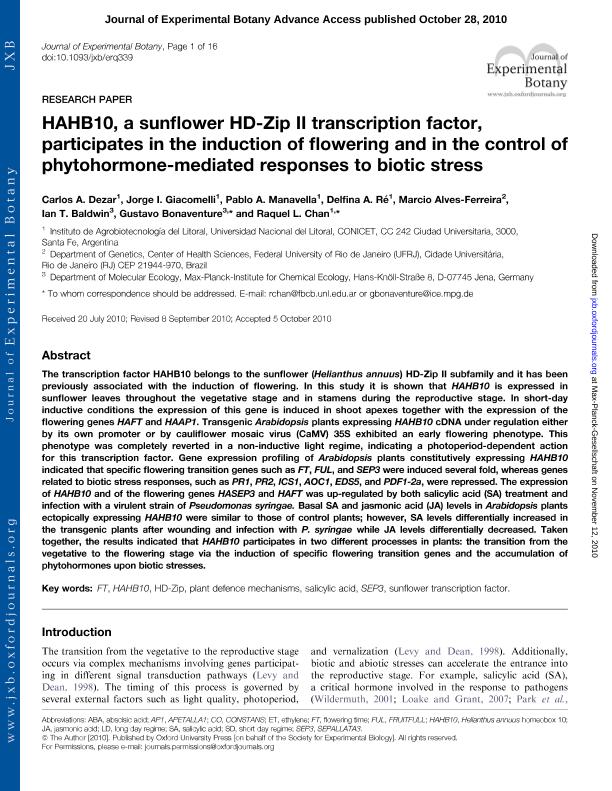Mostrar el registro sencillo del ítem
dc.contributor.author
Dezar, Carlos Alberto Alejandro

dc.contributor.author
Giacomelli, Jorge Ignacio

dc.contributor.author
Manavella, Pablo Andrés

dc.contributor.author
Ré, Delfina Adela

dc.contributor.author
Alves Ferreira, Marcio
dc.contributor.author
Baldwin, Ian
dc.contributor.author
Bonaventure, Gustavo
dc.contributor.author
Chan, Raquel Lia

dc.date.available
2024-02-02T14:23:43Z
dc.date.issued
2011-01
dc.identifier.citation
Dezar, Carlos Alberto Alejandro; Giacomelli, Jorge Ignacio; Manavella, Pablo Andrés; Ré, Delfina Adela; Alves Ferreira, Marcio; et al.; HAHB10, a sunflower HD-Zip II transcription factor, participates in the induction of flowering and in the control of phytohormone-mediated responses to biotic stress; Oxford University Press; Journal of Experimental Botany; 62; 3; 1-2011; 1061-1076
dc.identifier.issn
0022-0957
dc.identifier.uri
http://hdl.handle.net/11336/225599
dc.description.abstract
The transcription factor HAHB10 belongs to the sunflower (Helianthus annuus) HD-Zip II subfamily and it has been previously associated with the induction of flowering. In this study it is shown that HAHB10 is expressed in sunflower leaves throughout the vegetative stage and in stamens during the reproductive stage. In short-day inductive conditions the expression of this gene is induced in shoot apexes together with the expression of the flowering genes HAFT and HAAP1. Transgenic Arabidopsis plants expressing HAHB10 cDNA under regulation either by its own promoter or by cauliflower mosaic virus (CaMV) 35S exhibited an early flowering phenotype. This phenotype was completely reverted in a non-inductive light regime, indicating a photoperiod-dependent action for this transcription factor. Gene expression profiling of Arabidopsis plants constitutively expressing HAHB10 indicated that specific flowering transition genes such as FT, FUL, and SEP3 were induced several fold, whereas genes related to biotic stress responses, such as PR1, PR2, ICS1, AOC1, EDS5, and PDF1-2a, were repressed. The expression of HAHB10 and of the flowering genes HASEP3 and HAFT was up-regulated by both salicylic acid (SA) treatment and infection with a virulent strain of Pseudomonas syringae. Basal SA and jasmonic acid (JA) levels in Arabidopsis plants ectopically expressing HAHB10 were similar to those of control plants; however, SA levels differentially increased in the transgenic plants after wounding and infection with P. syringae while JA levels differentially decreased. Taken together, the results indicated that HAHB10 participates in two different processes in plants: the transition from the vegetative to the flowering stage via the induction of specific flowering transition genes and the accumulation of phytohormones upon biotic stresses.
dc.format
application/pdf
dc.language.iso
eng
dc.publisher
Oxford University Press

dc.rights
info:eu-repo/semantics/openAccess
dc.rights.uri
https://creativecommons.org/licenses/by-nc-sa/2.5/ar/
dc.subject
FT
dc.subject
HAHB10
dc.subject
HD-ZIP
dc.subject
PLANT DEFENCE MECHANISMS
dc.subject
SALICYLIC ACID
dc.subject
SEP3
dc.subject
SUNFLOWER TRANSCRIPTION FACTOR
dc.subject.classification
Bioquímica y Biología Molecular

dc.subject.classification
Ciencias Biológicas

dc.subject.classification
CIENCIAS NATURALES Y EXACTAS

dc.title
HAHB10, a sunflower HD-Zip II transcription factor, participates in the induction of flowering and in the control of phytohormone-mediated responses to biotic stress
dc.type
info:eu-repo/semantics/article
dc.type
info:ar-repo/semantics/artículo
dc.type
info:eu-repo/semantics/publishedVersion
dc.date.updated
2024-02-02T13:27:48Z
dc.journal.volume
62
dc.journal.number
3
dc.journal.pagination
1061-1076
dc.journal.pais
Reino Unido

dc.journal.ciudad
Oxford
dc.description.fil
Fil: Dezar, Carlos Alberto Alejandro. Consejo Nacional de Investigaciones Científicas y Técnicas. Centro Científico Tecnológico Conicet - Santa Fe. Instituto de Agrobiotecnología del Litoral. Universidad Nacional del Litoral. Instituto de Agrobiotecnología del Litoral; Argentina
dc.description.fil
Fil: Giacomelli, Jorge Ignacio. Consejo Nacional de Investigaciones Científicas y Técnicas. Centro Científico Tecnológico Conicet - Santa Fe. Instituto de Agrobiotecnología del Litoral. Universidad Nacional del Litoral. Instituto de Agrobiotecnología del Litoral; Argentina
dc.description.fil
Fil: Manavella, Pablo Andrés. Consejo Nacional de Investigaciones Científicas y Técnicas. Centro Científico Tecnológico Conicet - Santa Fe. Instituto de Agrobiotecnología del Litoral. Universidad Nacional del Litoral. Instituto de Agrobiotecnología del Litoral; Argentina
dc.description.fil
Fil: Ré, Delfina Adela. Consejo Nacional de Investigaciones Científicas y Técnicas. Centro Científico Tecnológico Conicet - Santa Fe. Instituto de Agrobiotecnología del Litoral. Universidad Nacional del Litoral. Instituto de Agrobiotecnología del Litoral; Argentina
dc.description.fil
Fil: Alves Ferreira, Marcio. Universidade Federal do Rio de Janeiro; Brasil
dc.description.fil
Fil: Baldwin, Ian. Instituto Max Planck Institut für Chemische Okologie; Alemania
dc.description.fil
Fil: Bonaventure, Gustavo. Instituto Max Planck Institut für Chemische Okologie; Alemania
dc.description.fil
Fil: Chan, Raquel Lia. Consejo Nacional de Investigaciones Científicas y Técnicas. Centro Científico Tecnológico Conicet - Santa Fe. Instituto de Agrobiotecnología del Litoral. Universidad Nacional del Litoral. Instituto de Agrobiotecnología del Litoral; Argentina
dc.journal.title
Journal of Experimental Botany

dc.relation.alternativeid
info:eu-repo/semantics/altIdentifier/url/https://academic.oup.com/jxb/article/62/3/1061/478718
dc.relation.alternativeid
info:eu-repo/semantics/altIdentifier/doi/http://dx.doi.org/10.1093/jxb/erq339
Archivos asociados
